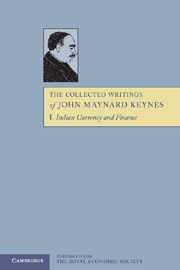Book contents
- Frontmatter
- Contents
- General introduction
- Editorial foreword
- Preface
- Dramatis personae
- 1 THE PRESENT POSITION OF THE RUPEE
- 2 THE GOLD-EXCHANGE STANDARD
- 3 PAPER CURRENCY
- 4 THE PRESENT POSITION OF GOLD IN INDIA AND PROPOSALS FOR A GOLD CURRENCY
- 5 COUNCIL BILLS AND REMITTANCE
- 6 THE SECRETARY OF STATE'S RESERVES AND THE CASH BALANCES
- 7 INDIAN BANKING
- 8 THE INDIAN RATE OF DISCOUNT
- Index
- Chart showing the rate of discount at the Presidency Bank of Bengal
5 - COUNCIL BILLS AND REMITTANCE
Published online by Cambridge University Press: 05 November 2012
- Frontmatter
- Contents
- General introduction
- Editorial foreword
- Preface
- Dramatis personae
- 1 THE PRESENT POSITION OF THE RUPEE
- 2 THE GOLD-EXCHANGE STANDARD
- 3 PAPER CURRENCY
- 4 THE PRESENT POSITION OF GOLD IN INDIA AND PROPOSALS FOR A GOLD CURRENCY
- 5 COUNCIL BILLS AND REMITTANCE
- 6 THE SECRETARY OF STATE'S RESERVES AND THE CASH BALANCES
- 7 INDIAN BANKING
- 8 THE INDIAN RATE OF DISCOUNT
- Index
- Chart showing the rate of discount at the Presidency Bank of Bengal
Summary
Remittance by means of what are termed council bills is a feature peculiar to the Indian system, and is not, so far as I know, to be paralleled elsewhere. It arises partly from the historical circumstance that the government of India is the successor of a trading company, partly from the necessity under which the government lies of making very large annual remittances to England.
The home charges, that is, the payments which the government of India must make in England, for interest on debt, pensions, payments to the War Office, government stores (not chargeable to capital), etc., amount to £19 million or £20 million annually. But the amount which it is necessary to remit, apart from extraordinary remittances to be dealt with later, is usually less than this; for the amount of new capital raised by government in England usually exceeds their capital expenditure in this country on repayments and on railway materials, etc. Thus the amount which it is necessary to remit to England annually is from £15 million to £18 million. Rupees to this amount, being part of the revenue from taxation, etc., accumulate in the Indian treasuries. This value is remitted to England by selling for sterling in London bills which can be cashed in rupees in Calcutta. Thus the government of India pays out rupees in Calcutta when the bills are presented, and the secretary of state's balances at the Bank of England are swelled by a corresponding amount.
- Type
- Chapter
- Information
- The Collected Writings of John Maynard Keynes , pp. 72 - 87Publisher: Royal Economic SocietyPrint publication year: 1978



